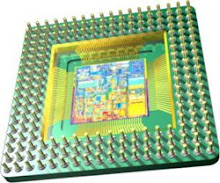Here's the set of assembly language instructions that the designer might create for the simple microprocessor in our example:
- LOADA mem - Load register A from memory address
- LOADB mem - Load register B from memory address
- CONB con - Load a constant value into register B
- SAVEB mem - Save register B to memory address
- SAVEC mem - Save register C to memory address
- ADD - Add A and B and store the result in C
- SUB - Subtract A and B and store the result in C
- MUL - Multiply A and B and store the result in C
- DIV - Divide A and B and store the result in C
- COM - Compare A and B and store the result in test
- JUMP addr - Jump to an address
- JEQ addr - Jump, if equal, to address
- JNEQ addr - Jump, if not equal, to address
- JG addr - Jump, if greater than, to address
- JGE addr - Jump, if greater than or equal, to address
- JL addr - Jump, if less than, to address
- JLE addr - Jump, if less than or equal, to address
- STOP - Stop execution

No comments:
Post a Comment